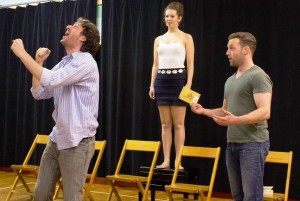“I’m standing in the street feeling murderous toward this prostitute, thinking about stabbing and stabbing and stabbing her and I know she doesn’t deserve it.”
This expression of raw emotion is uttered in the compelling Second Act of Toni Press-Coffman’s Touch. Directed by Deborah Mathieu-Byers, these powerful words are spoken by the play’s protagonist Kyle Kalke (Jonathan Berenson), a heart-broken astronomer, struggling to come to terms with the murder of his wife Zoe (Rachel Spencer). He tries explaining to his best friend Bennie Locasto (Mike Petrie, Jr.) how he began seeing a prostitute in the wake of his wife’s murder.
The moment Kyle, full of rage and desire, first encounters the prostitute is the point of attack when the play should begin because something vital is at stake where a conflict will lead up to a crisis and the protagonist has reached a turning point in his life. Yet inexplicably, Press-Coffman, an experienced and award-winning playwright has made the near fatal error of filling the first act with tedious exposition and characterization.
How could someone so accomplished make such a miscalculation? I have no idea. But it’s as if she didn’t realize how good the writing and acting are in the second act — at times electrifying and chilling. As Lajos Egri said in his 1946 classic treatise on playwriting The Art of Dramatic Writing: “A play should start with the first line uttered. The characters involved will expose their natures in the course of conflict. It is bad playwriting first to marshal your evidences, drawing in the background, creating an atmosphere, before you begin the conflict.”
Yet in the opening monologue, which seems to drag on interminably, Press-Coffman seems determined to disregard Egri’s wise counsel. She marshals her evidences, draws in the background, and creates an atmosphere, before beginning the conflict. We learn that Kyle was an introverted nerd who became fascinated with astronomy and star gazing, and how he fell in love with and eventually married the Annie Hall-like Zoe. Mercifully, the opening monologue ends and so does the first act as Kyle recalls the night his wife was murdered.
It is in Act II where the play really begins.
The energy in the theater changed when the prostitute Kathleen (Dorothy McMillan) strode onto the stage in daisy dukes over fishnet stockings, and a red bra under a lace top (kudos to costume designer Miodrag Guberinic). Kathleen filled the theater with the sweet stank of sex. As she strutted to the front of the stage and began soliciting audience members, she supplied the edge, sexual energy, and spunk the play so desperately needed. But why did we have to wait so long to see her?
Interestingly, Kyle is a much more compelling character when talking about his raw, strictly sexual relationship with the prostitute, than when he is reminiscing about his love for his murdered wife. While explaining to his best friend the erotic charge and rejuvenating force which Kathleen has brought into his life, he comes alive. In these moments, the writing and the acting sparkle. In one passage Kyle says, “Because I can feel myself making and expending energy again. Because when I’m lost inside this woman’s body, I don’t think about who killed Zoe. I don’t think about how much pain she might have been in before she died.” If only there had been more moments like these!
As advertised, this staging of Touch by Avalon Studios NYC was a multimedia affair — Jarrel Lynch (production design), Nicholas Ortiz (photography) and Max Ridgeway (media design). Unfortunately, the use of the jumbo screen which hovered above Marija Plavsic Kostic’s stage — two opposing chairs and a raised platform with a pile of rocks — could hardly have been less imaginative. Throughout Act I, this potentially powerful media serves merely to echo the protracted backstory: Kyle mentions first seeing Zoe in a science class. An image of Zoe leaving a classroom flashes on the screen. Kyle recalls their winter vacation in New York. Pictures of a snow-covered New York flash on the screen.
What a waste.
These images would have been much more compelling if woven seamlessly throughout the play, rather than dumped at the beginning. If images of Kyle’s murdered wife had flashed on the screen during his tense and initially guilt-ridden encounters with the prostitute, they would have added layers of meaning and heightened the dramatic intensity.
One only hopes that this play is restructured and restaged. There is too much good, serious and compelling work here not to be put together more thoughtfully.


